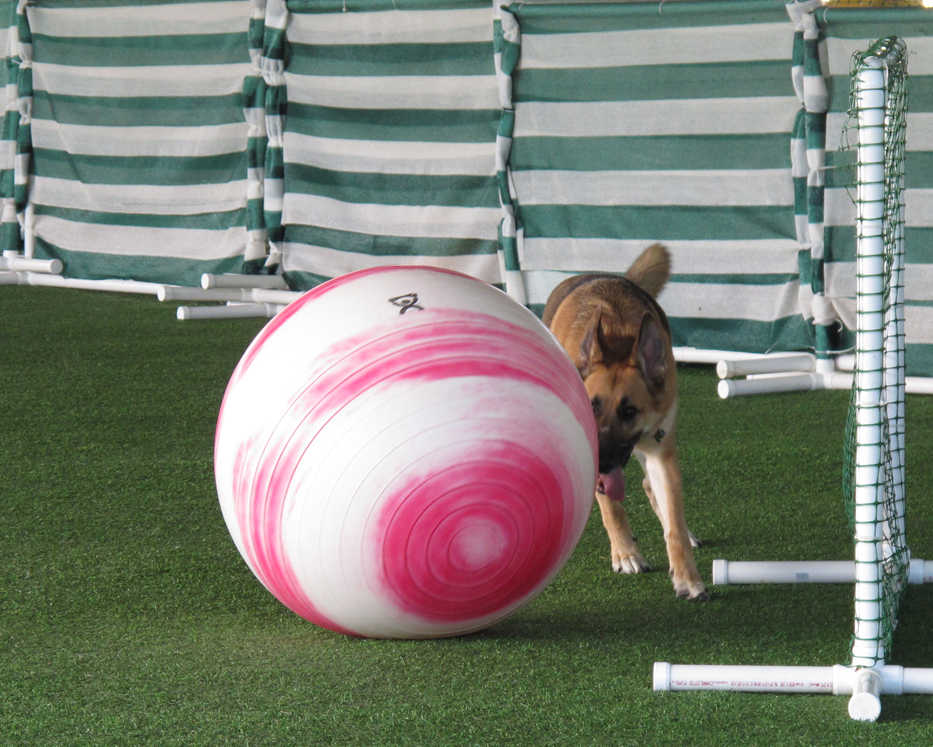YOUNGSVILLE, N.C. — With shouts of “point” and “drive” from her handler, the 3-year-old German shepherd charges into the triangle of brightly colored rubber orbs, scattering them with her nose like a cue breaking balls on a pool table. Then, zigging and zagging, Riley nudges the big purple one expertly down the field and into the goal.
“There’s a good girrrrrrl,” Melissa Breau coos as she engages in a brief tug-of-war with Riley’s favorite chew toy. Playtime over, Breau calls out to the judge for the next ball color.
“Light green,” comes the shout. And Riley is off.
This is Treibball — German for “drive ball,” or more loosely translated, “ball herding”.
The sport originated in that country about a decade ago, migrating to the United States four years ago where it’s still on a roll.
“Our organization has grown literally from just a few people to a little over 400 people in six countries,” says Dianna Stearns, co-founder and current president of the American Treibball Association. Another group, the Montana-based World Treibball League, started in 2012.
Bobby Chastain, one of about 140 ATA-certified Treibball instructors, says the sport helps dogs develop focus, confidence and impulse control.
“We have a lot of reactive dogs in it,” says Chastain, whose own dogs compete. “We have a lot of shy dogs in it. We have a lot of dogs that have a tremendous amount of energy. It helps burn the energy, but also can help calm a dog with high anxiety, because they’re working.”
The sport’s creator, Jan Nijboer, a Dutch hunting and herding dog trainer, noticed his clients’ dogs pushing their water dishes around after their lessons. Realizing they still had plenty of energy, he wondered if he could teach them to play soccer, says Stearns.
And Treibball was born. The rules are pretty simple.
Eight exercise balls are arranged in a triangle at center field. Depending on the age and size division of the dog, the canines have seven to 10 minutes — dogs 7 years and up get an extra two minutes — to “herd” them toward their handler and into a goal.
Since dogs don’t see as many colors as humans do and also perceive color differently, handlers use directional commands like “center,” ‘’back” and “over” to coax the animals to the correct ball. When the dog reaches the right one, the handler shouts “push” or “drive.”
“It’s kind of a fun trick to demonstrate to people,” says Kathleen Kiernan, whose Cockapoo, Angus, competed in the “teacup” division during a recent meet at the Teamworks Dog Training arena north of Raleigh.
The ATA group held its first national competitions last year in Colorado, Michigan and North Carolina. This year, they added a fifth meet.
The sport is so new here that only three dogs have reached champion level.
“We had to have a critical mass of trainers and students who knew the game before we could hold competitions and issue titles,” Stearns says.
Two of Karen Mielke’s pups achieved that goal during the recent meet in Youngsville — Luna, an Australian shepherd, and Cheyenne, a 9-year-old German shepherd rescue. Mielke, who runs her own training business, was especially proud of Cheyenne.
“She’s very reactive to other dogs, so we’ve worked a lot to bring her down to be more calm,” she said, stroking Cheyenne’s thick brown and black coat and kissing her on the head. “She loves it. Don’t you? You like to chase those balls.”
But for most of these pet parents, it’s not about the ribbons and trophies. It’s about quality of life.
Marcia Pines’ 11-year-old Belgian Tervuren, Logan, has been a titled agility dog. The Wake Forest, North Carolina woman sees Treibball as a low-impact way to keep him active and stimulated “in his golden years.”
“He’s starting to get up there, and I don’t want him to injure himself,” she says. “Who says you can’t teach an old dog new tricks?”

